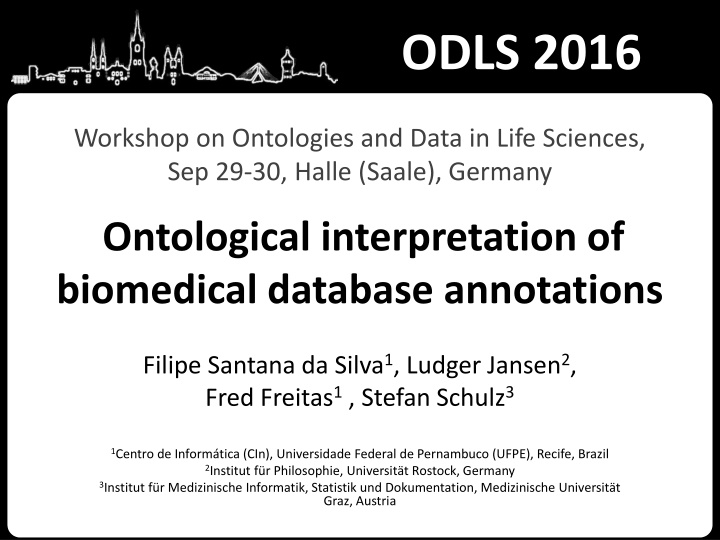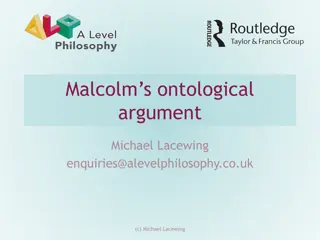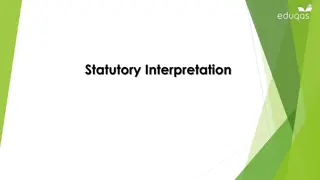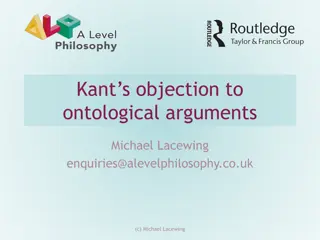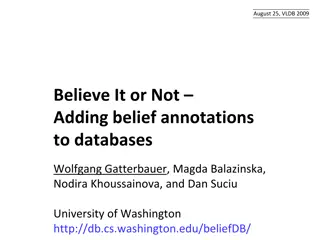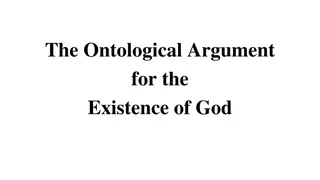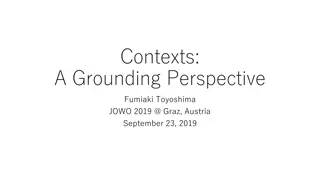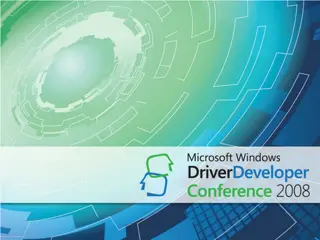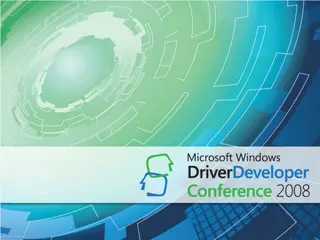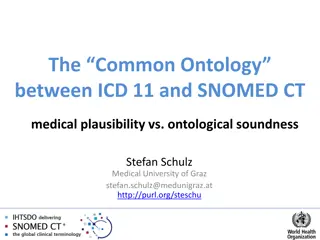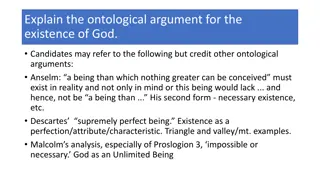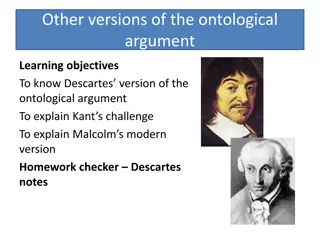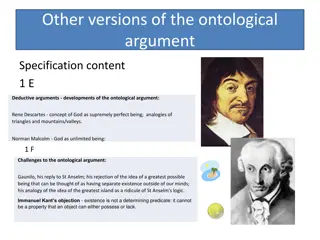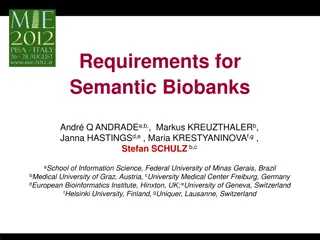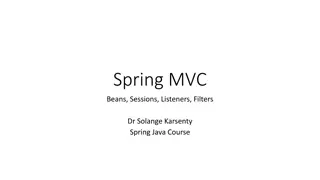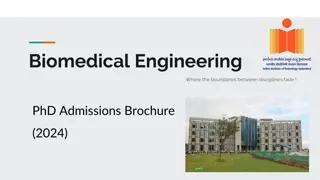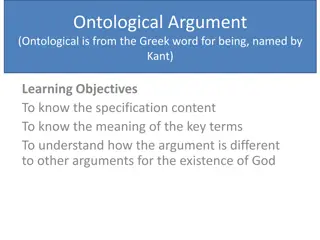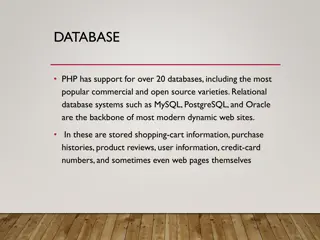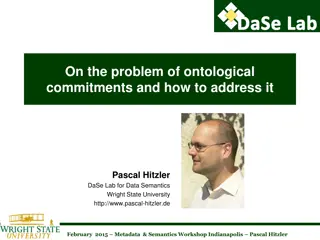Ontological Interpretation of Biomedical Database Annotations
Workshop at ODLS 2016 focused on the relationship between biological databases and bio-ontologies, exploring how their content can be expressed using unified models of meaning. The role of OWL in bio-ontology content expression versus database structure was analyzed through examples of tabular bio-DB structures and the annotation of laboratory experiment results.
Download Presentation

Please find below an Image/Link to download the presentation.
The content on the website is provided AS IS for your information and personal use only. It may not be sold, licensed, or shared on other websites without obtaining consent from the author.If you encounter any issues during the download, it is possible that the publisher has removed the file from their server.
You are allowed to download the files provided on this website for personal or commercial use, subject to the condition that they are used lawfully. All files are the property of their respective owners.
The content on the website is provided AS IS for your information and personal use only. It may not be sold, licensed, or shared on other websites without obtaining consent from the author.
E N D
Presentation Transcript
ODLS 2016 Workshop on Ontologies and Data in Life Sciences, Sep 29-30, Halle (Saale), Germany Ontological interpretation of biomedical database annotations Filipe Santana da Silva1, Ludger Jansen2, Fred Freitas1, Stefan Schulz3 1Centro de Inform tica (CIn), Universidade Federal de Pernambuco (UFPE), Recife, Brazil 2Institut f r Philosophie, Universit t Rostock, Germany 3Institut f r Medizinische Informatik, Statistik und Dokumentation, Medizinische Universit t Graz, Austria
Biological Databases and Bio-Ontologies Two worlds: Bio-DBs Bio-ontologies How are they related to each other? Can their content be expressed by a unified model of meaning? Is database content of ontological nature? Can OWL be used as a language to express bio-ontology content bio-database structure bio-database content Which is the added value?
Biological Databases and Bio-Ontologies Two worlds: Bio-DBs Bio-ontologies Store summarized results of laboratory experiments Classical database structure Values: Numeric Textual Symbolic (codes from ontologies) Provide definitions Provide axioms that are universally true Obey formal semantics Main use case: annotation of biological database entries
Example tabular Bio-DB structure PR PR Gene Organism (NCBI Tax) GO Biological Process GO Molecular Function GO Cellular componente Ensembl Phenotype ID Ensembl ID Protein F1MEW4 CBS CBS Bos tautus blood vessel remodelling;... Cysthationine beta- synthase;... cytoplasm;... ENSBTAT00000000184; ... No phenotype associated Q99707 MS MS Homo sapiens cobalamin metabolic process;... cobalamin binding;... cytoplasm;... ENST000000366577; ENST000000533889 Neural tube defect.; Megaloblastic anemia;... F1RF82 MTHFR MTHFR Sus scrofa homocysteine metabolic process;... modified amino acid binding;... cytosol ENSSSCT00000003805 No phenotype associated Q93088 BHMT BHMT Homo sapiens amino acid betaine catabolic process;... zinc ion binding;... protein complex;... ENST00000274353 Liver tumor; Coronary artery disease;...
Example tabular Bio-DB structure PR PR Gene Organism (NCBI Tax) GO Biological Process GO Molecular Function GO Cellular componente Ensembl Phenotype ID Ensembl ID Protein F1MEW4 CBS CBS Bos tautus blood vessel remodelling;... Cysthationine beta- synthase;... cytoplasm;... ENSBTAT00000000184; ... No phenotype associated is included in Q99707 MS MS Homo sapiens cobalamin metabolic process;... cobalamin binding;... cytoplasm;... ENST000000366577; ENST000000533889 Neural tube defect.; Megaloblastic anemia;... is included in is included in is included in F1RF82 MTHFR MTHFR Sus scrofa homocysteine metabolic process;... modified amino acid binding;... cytosol ENSSSCT00000003805 No phenotype associated is participant in is part of Q93088 BHMT BHMT Homo sapiens amino acid betaine catabolic process;... zinc ion binding;... protein complex;... ENST00000274353 Liver tumor; Coronary artery disease;... includes
Example tabular Bio-DB structure more abstract: a database record informs about experimental evidence that: Proteins of the type Prot1 participate in Processes of type BProc1 BProck within organisms of type Org1 are active in cellular components of type CComp1 or CComp2or CCompx within organisms of type Org1 participate in Processes that have small molecules of type Mol1, Mol2 Moly as outcome within organisms of type Org1 if dysfunctional Org1has dispositions to develop the phenotypes (disorders) Phen1 Phenz This information is not explicitly contained in the database it is implicitly shared by database users and curators
Ontological framework Information entities Domain entities Homo sapiens Megaloblastic anemia Cobalamin binding Methionin synthase ( ) Bio-DB Database record Data item Classes (T-Box) John Doe, of which tissue is stored in a biobank and analysed in a lab John's megaloblatic anemia A cobalamin binding process observed in the lab within a tissue sample from John a dysfunctional Methionin synthase protein molecule in John's tissue Uniprot Ensembl Database record about Methionin Synthase in Homo Sapiens Data item, such as "cobalamin binding" in this record Individuals (A-Box)
Denotation Information entities Domain entities Homo sapiens Megaloblastic anemia Cobalamin binding Methionin synthase ( ) Bio-DB Database record Data item Classes (T-Box) individual to class John Doe, of which tissue is stored in a biobank and analysed in a lab John's megaloblatic anemia A cobalamin binding process observed in the lab within a tissue sample from John a dysfunctional Methionin synthase protein molecule in John's tissue Uniprot Ensembl Database record about Methionin Synthase in Homo Sapiens Data item, such as "cobalamin binding" in this record individual to individual Individuals (A-Box)
Case 1: database entry represents individuals Information entities Domain entities Homo sapiens Megaloblastic anemia Cobalamin binding Methionin synthase ( ) R1 P1 O1 C1 Pt1 Pr1 Bio-DB Database record Data item Classes (T-Box) individual to class John Doe, of which tissue is stored in a biobank and analysed in a lab John's megaloblatic anemia A cobalamin binding process observed in the lab within a tissue sample from John a dysfunctional Methionin synthase protein molecule in John's tissue Uniprot Ensembl Database record about Methionin Synthase in Homo Sapiens Data item, such as "cobalamin binding" in this record o1 pt pt1 Individuals (A-Box) btl2:represents r p1 pr1 c c1
Multiple defined subclasses Case 2: database entry represents classes Information entities Domain entities Homo sapiens Megaloblastic anemia Cobalamin bnding Methionin synthase ( ) or P1 O1 C1 Pt1 Pr1 Bio-DB Database record Data item Classes (T-Box) P1 O1 C1 Pt1 Pr1 P1 O1 O1a C1 C1a Pt1 Pt1a Pr1 Pr1a P1a John Doe, of which tissue is stored in a biobank and analysed in a lab John's megaloblatic anemia A cobalamin binding process observed in the lab within a tissue sample from John a dysfunctional Methionin synthase protein molecule in John's tissue Uniprot Ensembl Database record about Methionin Synthase in Homo Sapiens Data item, such as "cobalamin binding" in this record btl2:represents rdf:Type only Individuals (A-Box) r
Multiple defined subclasses P1 O1 C1 Pt1 Pr1 P1 O1 O1a C1 C1a Pt1 Pt1a Pr1 Pr1a P1a or
Querying: A-box query for individuals Information entities Domain entities Homo sapiens Megaloblastic anemia Cobalamin binding Methionin synthase ( ) R1 P1 O1 C1 Pt1 Pr1 Bio-DB Database record Data item Classes (T-Box) individual to class John Doe, of which tissue is stored in a biobank and analysed in a lab John's megaloblatic anemia A cobalamin binding process observed in the lab within a tissue sample from John a dysfunctional Methionin synthase protein molecule in John's tissue Uniprot Ensembl Database record about Methionin Synthase in Homo Sapiens Data item, such as "cobalamin binding" in this record o1 pt pt1 Individuals (A-Box) btl2:represents r p1 pr1 c c1
Querying: T-box query for subclasses Information entities Domain entities Homo sapiens Megaloblastic anemia Cobalamin bnding Methionin synthase ( ) or P1 O1 C1 Pt1 Pr1 Bio-DB Database record Data item Classes P1 O1 C1 Pt1 Pr1 P1 O1 O1a C1 C1a Pt1 Pt1a Pr1 Pr1a P1a John Doe, of which tissue is stored in a biobank and analysed in a lab John's megaloblatic anemia A cobalamin binding process observed in the lab within a tissue sample from John a dysfunctional Methionin synthase protein molecule in John's tissue Uniprot Ensembl Database record about Methionin Synthase in Homo Sapiens Data item, such as "cobalamin binding" in this record btl2:represents rdf:Type only Individuals r
Querying: T-box query for subclasses Information entities Domain entities Homo sapiens Megaloblastic anemia Cobalamin bnding Methionin synthase ( ) P1 O1 C1 Pt1 Pr1 Bio-DB Database record Data item Classes P1 O1 C1 Pt1 Pr1 P1 O1 O1a C1 C1a Pt1 Pt1a Pr1 Pr1a P1a John Doe, of which tissue is stored in a biobank and analysed in a lab John's megaloblatic anemia A cobalamin binding process observed in the lab within a tissue sample from John a dysfunctional Methionin synthase protein molecule in John's tissue Two step DL query: Does subclass exist? if not: no database entry else: determine superclass from bioontology Uniprot Ensembl Database record about Methionin Synthase in Homo Sapiens Data item, such as "cobalamin binding" in this record Individuals
Competency questions (Q1) Which biological processes have proteins of the kind Proti as participants? BProc1and ( has participant some Proti) (Q2) In which cellular locations is Proti active in organisms of the type Org1? Cellular component and ( is included in some Org1) and (includes some Proti) (Q3) Which proteins are involved in processes of the type BProc in organisms of the type Org1? Protein and ( is participant in some BProc1 ) and ( is included in some Org1)
Evaluation (one database record) Axioms/ Assertions Model Q1 Q2 Q3 Classes Individuals A- Box bp1001, bp2001, bp3001 cc1001, cc2001, cc3001 p1004 24 51 207 T- Box BProc1 CComp1 Proti 68 0 149
Discussion (I) Both modelling solutions: highly productive scaling problems to be expected A-Box solution (prototypical individuals): A-box reasoning more costly Makes existential assumptions T-Box solution (multiple subclasses) Theoretically allows non-referential entries Simplified model: EL++
Discussion (II) Do biological database refer to ontological content? No "real" universal statements on biological entities Even no existential assumption Dispositional statements to be discussed (see paper) Exercise best described as ontological representation of referring individuals Possible use case: non-disruptive querying of Bio-DBs where axioms of the annotation ontologies need to be explored
Conclusion Four ontological approaches - IND, SUBC, DISP and HYB Structure and content of BIO-DBs Solution: Expressiveness, DB retrieval and retrieval based on DL queries Interpretation: Denoted entities as prototypical individuals Creation of defined subclasses Database content as reporting dispositions
Funding: This work was funded by Conselho Nacional de Aperfeioamento de Pessoal de N vel Superior (CAPES) 3914/2014-03 and Conselho Nacional de Desenvolvimento Cient fico e Tecnol gico (CNPq) 140698/2012-4.
